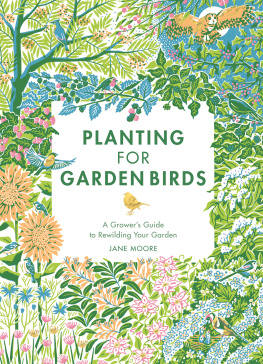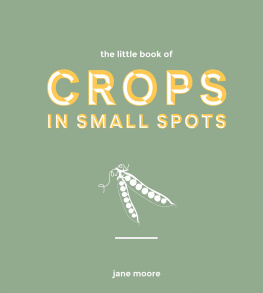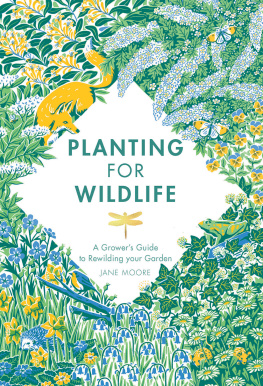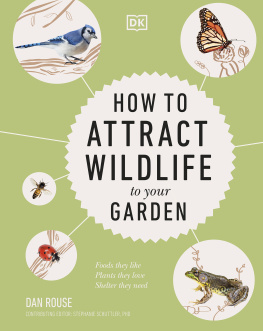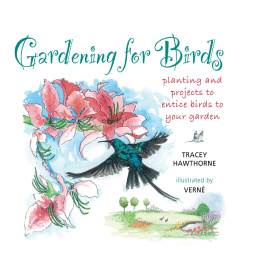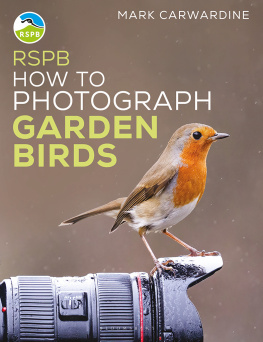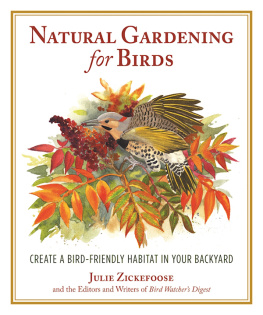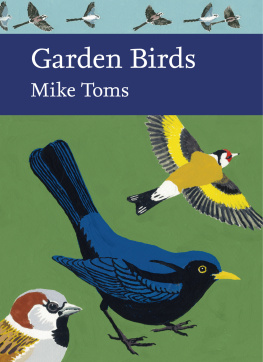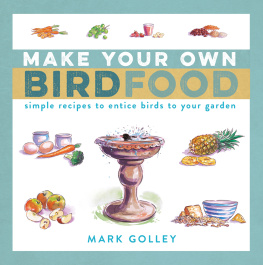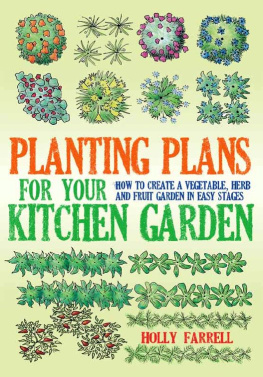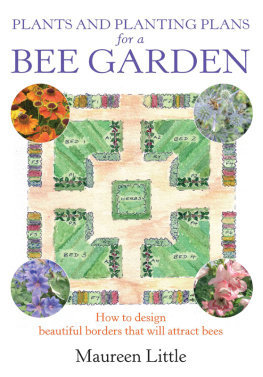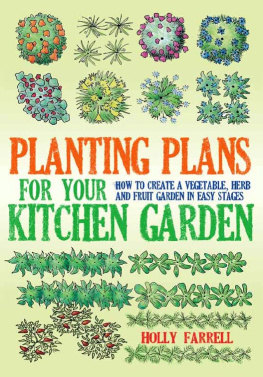
For Andrew and Christina,
working in your garden
was the inspiration

Theres more to our gardens than a few pigeons. Whether theyre in villages, towns or cities, all kinds of birds live in and around them, from humble House Sparrows and shy little Wrens to majestic Herons and breath-taking Peregrine Falcons. To a Peregrine, a city high-rise is ideal for nesting on, just like a cliff. The church spire close to my city home is famous for its resident Peregrines and I often hear their piercing call. Theres no doubt that our homes and gardens have become increasingly important habitats for birds, even those we think of as countryside inhabitants.
Take a stroll in your local park and youll probably see various types of Tits and Finches, perhaps a Woodpecker, or even a Kestrel or Sparrowhawk. If theres a lake or river nearby, youre likely to see Herons, Coots, Moorhens and, if youre lucky, the electric blue streak of a Kingfisher.
Some birds are residents and are around from day to day, but others are fleeting visitors, arriving purely for the summer months or passing through the garden in just a day or two. But theyre all potential guests in our gardens if we make the environment suitably welcoming. Thats exactly what this book is about. In these pages youll find straightforward ideas and easy-to-achieve plans that will make your garden irresistible to birds.
The aim of this book is to broaden your knowledge and expertise, to give you ideas on planting and on how to manage your garden in a bird-friendly fashion. The planting chapters are arranged seasonally to make planning your garden easier. Your garden can be beautiful as well as bird friendly, so the plants are listed in their main season of interest for us gardeners. For instance, the Cherry is listed in spring, as thats when these beautiful trees flower, but its mainly the late summer fruit that will attract the birds. Having said that, many plants have several seasons of interest, so Ive tried to mention all of them. But its by no means a definitive list; these are the plants that I rate as both good for birds but also as great additions to the garden.

A t first glance thats such an easy question to answer. Birds add life, colour and song to our gardens. They live their lives alongside us, eating, meeting a partner, settling down and bringing up their chicks in a parallel existence to our own. But the thing I really love about birds is the fact that many of them are with us all year round. Robins, Blackbirds, Sparrows and Dunnocks are in my garden whatever the season. Some of them, like the Robin, keep me company as I potter about the garden, especially in winter. Others, like the Sparrows, flit off chattering away as soon as I get too close. But its the shy little Wren that really has my heart a glimpse of this stalwart little bird hopping about busily makes me realize just how important my garden is for all the birds, including the ones I rarely see.
But, while theyre beautiful to see and hear, many birds are doing quite a service for us gardeners, so its well worth making an effort for them. Many of the most common garden birds, such as Finches and Sparrows, are seed eaters and they dont discriminate, happily eating weed seeds at a great rate and reducing the amount left to germinate. That means less weeding and no need for chemical weed killers for me. Some, such as Song Thrushes, will even tuck into slugs and snails and thats great news for every gardener.
Were so used to seeing birds all the time that we take them for granted without particularly realizing it. Theyre always there, all around us, flying overhead, the spring song of the Blackbird waking us up at dawn and the bold little Robin at our side looking for worms when were gardening in the winter. I cant imagine these commonplace birds not being around the world, let alone my garden, would be so dull and lifeless.
In recent years, weve come to realize just how important urban parks and gardens are for wildlife they are the green lungs of our towns and cities. The natural spaces our towns have to offer are increasingly becoming home to wildlife of all kinds, including birds. Many creatures are migrating into urban environments in search of food and shelter, which has become scarcer in the countryside. It doesnt matter if you make a nest on a skyscraper, office block or a cliff if youre a Peregrine Falcon, as long as its safe, secure and close to plenty of prey. Villages, towns and cities offer an array of potential habitats, from quiet cemeteries and churchyards, with their old trees and neglected corners, to scraps of wasteland, railways lines, and even empty buildings.
Theres no doubt that many common birds are threatened by various factors, among them loss of food. In 2007 the House Sparrow, Song Thrush and Starling were added as priority species to the UK Biodiversity Action Plan list. This means these once-common birds are now species to worry about. The numbers of House Sparrows, Starlings and Song Thrushes have gone down by more than half over the last 25 years. Its a similar story in the USA where breeding bird populations have dropped by 29 per cent in the past 40 years. While some of this is caused by changes in farming practices, scientists believe that the loss of insects the birds feed upon in towns and cities could also be to blame. This means we need to make sure our gardens are full of insects for birds to eat, and nothing attracts insects more than plants.
Of course, feeding birds in any way you can is paramount. Those bird feeders might feel like a miniscule effort to change things for the better, but everything has an impact. In the US, 57 million households regularly feed their local birds, while bird lovers in the UK spend more than 200 million a year on bird food, feeders and other bird paraphernalia.
While putting out food is crucial, a more holistic approach is essential to create an environment where the birds will live out their whole lives. By planting a wide range of native and bird- and insect-friendly species, you will not only attract birds to feed on the plants in your garden but insects on which many more birds will also feed. The more plants you grow, the more insects will be drawn in and so the more birds will follow. Not only that, but you wont feel the need to use insecticides as the birds will manage the insect populations for you biological control in action.
In recent decades several big citizen science events have become annual, including the Big Garden Birdwatch, organized by the RSPB in the UK, and the Great Backyard Bird Count, headed by Audubon in the USA. Ordinary citizens have great fun recording their local birds, while providing scientists with crucial information. And initiatives like this exist all over the world. Theres even a continent-wide one in the form of EuroBirdwatch, organized by BirdLife Europe and Central Asia.
Our back gardens are playing an increasingly important role. The green corridor effect of hundreds of back gardens weaves its way through urban areas to open spaces such as parks, canals and rivers and then on into the wider countryside. These provide vital channels for migrating birds and insects, especially as our gardens arent likely to be built on or suffer from the overuse of pesticides and other threats in the same way as larger open spaces. By gardening sustainably and in an environmentally conscious manner, gardeners can make a considerable difference to the wildlife populations in their immediate area, as well as the country as a whole.

